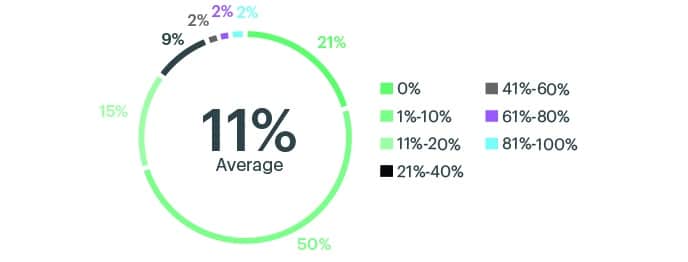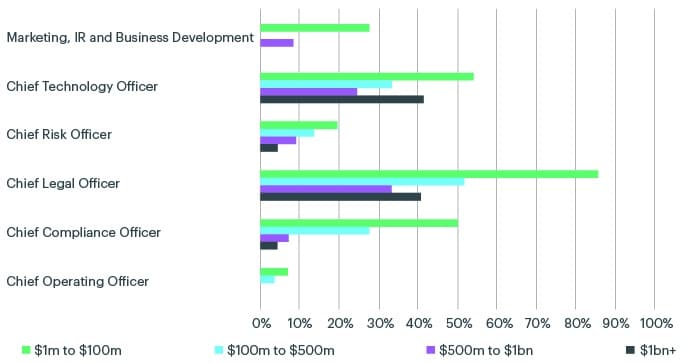by Rowen Pillay of Edgefolio: Raising capital in the hedge fund industry has traditionally depended on having a personal network of investor relationships. However in recent years, that model has been challenged by increased competition from cheaper, better performing products and scepticism about the effectiveness of actively managed funds. Managers, now facing pressure to reduce fees, are seeking new and more efficient approaches to maintain investor interest through the use of distribution technology and digital marketing.
Early Need for Marketing
In our recent study, with GPP and the AIMA, we looked at the driving growth behaviours for hedge funds. Most managers surveyed agreed on the importance of marketing to drive growth, however a key consideration and point of evidence, was on how much should a growing hedge fund be allocating to its marketing spend and at what stage in its initial growth should marketing be a priority.
Our respondents told us that passing the $100m AUM barrier is seen as a major milestone in a fund’s long-term success. Conventional wisdom says that building a fund to this threshold, with desirably low marketing costs, requires a degree of balance by demonstrating credibility with a robust track record before exposing the fund to a wider pool of potential investors.
However, it should not be surprising that 94% of managers with less than $100m AUM are actively marketing their fund to prospective investors. Additionally, those managers were spending an average of 19% of their fees revenue on marketing – up from an average of 11% for those managing over $100m AUM.
Percentage of management fees spent on marketing

Source: Making it Big Survey. AIMA, GPP & Edgefolio
Marketing and Communications Talent
For emerging funds, investing in marketing can be seen as unnecessary until the fund is larger. Although this chicken and egg scenario can be problematic for managers, it was clear that investing in marketing is critical and for the need to hire a marketer early in the fund’s lifecycle. Not one manager with greater than a billion dollars AUM nor any manager running between $100m and $500m AUM outsourced their marketing function.
In the cases where sub $100m fund managers did not invest in marketing, it was often the case that marketing responsibilities were taken on by the role of the CEO, CIO or COO – effectively diluting time dedicated to their primary role in the interim of having a dedicated marketing function.
Investors in our survey were also shown to receive marketing content positively and expressed the importance of maintaining access to the manager during and after the investment process. By offering allocators transparency around the hedge fund strategy, approach to risk and correlation to the market, smaller funds were able to mitigate the effects of having a short track record.
Managers with an internal resource or outsource the following function

Source: Making it Big Survey. AIMA, GPP & Edgefolio
Investors Desire Data
Investors in our survey cited that one of their main challenges was access to comparable fund data and the manual nature of due diligence in their allocation process. With a wider range of fund information and communication tools at their disposal, it’s clear that investors have come to demand a greater level of transparency, depth of information and more frequent interactions with their fund managers. Regardless of the role within the fund that fulfils a client’s need for information, there is a strong case for a solution to optimise the amount of time required to satisfy this need and to ensure a consistent, scalable approach to distributing this information.
Managers Investing in Distribution Technologies Outperform Competitors
Data, analytics and digital applications tend to have the effect of increasing efficiencies by removing intermediaries and associated costs. In many cases, they also permit more personalised interactions – effectively transforming transactions into relationships.
A recent Deloitte paper – ‘How Technology Will Redefine Relationships with Asset Management Clients’ describes how this new dynamic applies to the asset management industry, with a focus on how distribution technologies are creating a competitive advantage for asset managers.
While many asset managers have applied standard digital marketing tools and tactics, such as having a website and a social media presence, they are often not sufficient or sophisticated enough to communicate the depth and regularity of information to satisfy new investor needs.
The paper describes that while most leaders are aware of the growing expectations gap, many have addressed it by hiring more salespeople. Throughout 2012-2017, the industry’s estimated sales and marketing headcount ballooned by 50%. Such strategies often failed to pay off. During the three years ending 2017, those asset managers who ranked in the top third of peers for spending on distribution technology grew twice as fast as the industry overall in terms of net new flow, and eclipsed rivals in the bottom third, most of whom shrank.
Worldwide, asset managers spent an estimated $2.2 billion on distribution-related technology in 2017. Above-average investments in distribution technology tended to pay off for asset management firms with organic growth exceeding 2% per year, while net flows plummeted among weaker spenders.
Many of the managers surveyed realised the need to invest in technology in order to support a greater number of customised and complex relationships. Of those who excelled among their peers, nearly two-thirds of these distribution leaderslabelled technology or new talent as a key priority for the next three to five years.
Most significant changes identified by distribution leaders

Source: How Technology Will Redefine Relationships with Asset Management Clients. Deloitte
A Future in Partnership with Technology
Increased pressure on fund managers has made it ever more important for their time to be spent effectively and on value-generating tasks for their firm. Marketing has been found to be both a key growth opportunity and a critical investment to make in an emerging fund to ensure its future success. However, the time spent on this activity, particularly by non-marketing personnel in the firm, needs to be carefully vested to ensure that other functions are tended to and that investors are in regular communication with the management team.
A solution to these time pressures can be found in asset management technology. From the initial days of Edgefolio in the Nordic markets, our clients insight into this problem benefited our investor portal as a solution to automate repetitive communications and provide investors with the ability to self-serve a funds performance information and documents.
Although “transformation” has become an overused word, it truly describes what needs to take place among distribution organisations across the asset management industry. Asset managers must understand their clients rising expectations for levels of personalised service, which increasing headcount alone will no longer be able to meet without leveraging technology.
This article is a guest contribution by Rowen Pillay, CEO at Edgefolio.com
